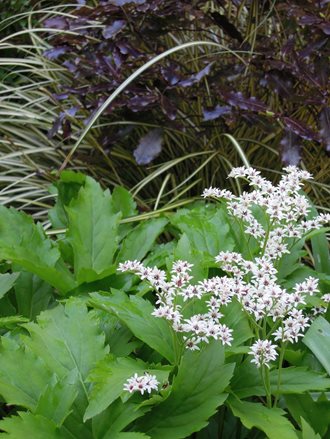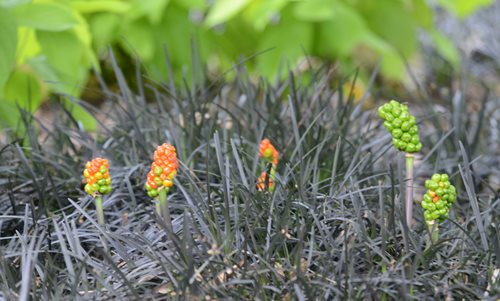Dark Desires

Deepest, darkest black. A colour scarcely found in flora. Nurserymen and breeders are always striving to increase the narrow range of plants on offer with inky tones in order to fulfil our quest for dark desires of that something a little bit different. On face value many plants give the appearance of being ‘black’ viewed from a distance, but look more closely and you will see they can be made up of any number of colours in their leaves encompassing aubergine, claret, and scarlet, to name but a few.
A trick many designers, including myself, use is to add dark foliage plants to planting schemes. This can bring light, shadow and depth even on the drabbest day along with a sense of mystery. Richness, elegance and drama in the planting can be hard to achieve with other vegetation, but dusky hues can help reach these goals. Used individually, a deeper tinted specimen becomes a focal point, or perhaps combined with well-chosen perennials it appears as a feature group, but don’t get too carried away as too much of a good thing can tip the scales and swiftly become overkill.
Often adding blooms in front of an obsidian backdrop stops the overall effect being too heavy. Introduce flowers gingerly and restrict your palette to either hot flame colours, such as red and orange, which adds drama or cool blues, violets and pinks which will achieve a subtle contrasting effect. You could try amber Trollius x cultorum intermingled with Polystichum ferns in front of purple-leaved hazel, Corylus avellana ‘Forscorubra’. Yellow and white will create striking juxtaposition, so best keep this to a minimum and stick to forms that give a light, airy and hazy effect such as Crambe cordifolia and popular annual Ammi majus.
Interspersing differing foliage with sombre neighbours contrasts well too. Think Acer palmatum 'Dissectum Atropurpureum' alongside silver felted leaves of Stachys byzantina 'Big Ears', the latter intensifying the formers deep leaf colour. Glaucous and lime green tones work too. Even a little variegation can be tried, possibly spaced apart by a block of green so as to calm any harshness between the two. I’ve mixed narrow leaved Carex oshimensis 'Evergold' with its golden stripe with the less well-known palmate leaf of Mukdenia rossii in my own garden. Both are used as companions to three purple-bronze leaved Pittosporum tenuifolium ‘Tom Thumb’, punctuating the border like a well-timed rhythm without becoming too overbearing.

Carex oshimensis 'Evergold' and Mukdenia rossii
backed by Pittosporum tenuifolium ‘Tom Thumb’
Planted in the shade darker colours tend to recede into the background and can get lost. Sunny situations provide a good, rich leaf colour, but that said some will cope better if a little bit of shade can be offered. Cotinus coggygria 'Royal Purple' as a backdrop to Spiraea japonica 'Anthony Waterer' is not such a combination as full sun will suit them best. The Cotinus with its opulent foliage offsets the Spiraea’s frothy fuschia pink flowers superbly and the foliage contrasts nicely too.
Small scale plants have the ability to blend into the earth, especially when viewed from a distance, unless lighter foliage is grown behind for contrast. Ophiopogon planiscapus 'Nigrescens' is an excellent case in point. Planted right at the front of the border next to a lawn or offset against light paving for best contrast. Choose strikingly different foliage to sit behind. Arum italicum subsp. italicum 'Marmoratum' (far easier to grow than to say) works well for this and provides a further season of interest when the Arum foliage dies down and the vivid orange-red berry spikes are left standing against the Ophiopogon’s leaves. Another worthy combination, and easier on the eye, is to team the Ophiopogon with Ajuga ‘Caitlin’s Giant with a line of Colchicum speciosum 'Atrorubens' dotted between the two for some autumn wow factor.

Spikes of Arum italicum subsp. italicum 'Marmoratum' nosing through
Ophiopogon planiscapus 'Nigrescens'
Discretion is vital when adding darker plants in order to not create an overly dominant scheme with shrubs merging together and disappearing into the distance, creating a void in the borders. The exact opposite of what you were trying to achieve. Dark subjects when placed will always be noticed, but not necessarily for the right reasons, so warily lay out your choice of plants first and live with it for a time before planting. Just because it is harder to pull this style of planting off doesn’t mean that you shouldn’t experiment using darker foliage and add some depth and mystery to your garden.